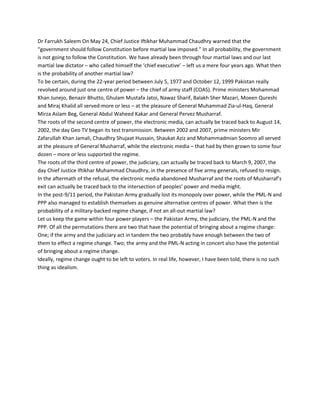Martial law
- 1. Dr Farrukh Saleem On May 24, Chief Justice Iftikhar Muhammad Chaudhry warned that the âgovernment should follow Constitution before martial law imposed.â In all probability, the government is not going to follow the Constitution. We have already been through four martial laws and our last martial law dictator â who called himself the âchief executiveâ â left us a mere four years ago. What then is the probability of another martial law? To be certain, during the 22-year period between July 5, 1977 and October 12, 1999 Pakistan really revolved around just one centre of power â the chief of army staff (COAS). Prime ministers Mohammad Khan Junejo, Benazir Bhutto, Ghulam Mustafa Jatoi, Nawaz Sharif, Balakh Sher Mazari, Moeen Qureshi and Miraj Khalid all served-more or less â at the pleasure of General Muhammad Zia-ul-Haq, General Mirza Aslam Beg, General Abdul Waheed Kakar and General Pervez Musharraf. The roots of the second centre of power, the electronic media, can actually be traced back to August 14, 2002, the day Geo TV began its test transmission. Between 2002 and 2007, prime ministers Mir Zafarullah Khan Jamali, Chaudhry Shujaat Hussain, Shaukat Aziz and Mohammadmian Soomro all served at the pleasure of General Musharraf, while the electronic media â that had by then grown to some four dozen â more or less supported the regime. The roots of the third centre of power, the judiciary, can actually be traced back to March 9, 2007, the day Chief Justice Iftikhar Muhammad Chaudhry, in the presence of five army generals, refused to resign. In the aftermath of the refusal, the electronic media abandoned Musharraf and the roots of Musharrafâs exit can actually be traced back to the intersection of peoplesâ power and media might. In the post-9/11 period, the Pakistan Army gradually lost its monopoly over power, while the PML-N and PPP also managed to establish themselves as genuine alternative centres of power. What then is the probability of a military-backed regime change, if not an all-out martial law? Let us keep the game within four power players â the Pakistan Army, the judiciary, the PML-N and the PPP. Of all the permutations there are two that have the potential of bringing about a regime change: One; if the army and the judiciary act in tandem the two probably have enough between the two of them to effect a regime change. Two; the army and the PML-N acting in concert also have the potential of bringing about a regime change. Ideally, regime change ought to be left to voters. In real life, however, I have been told, there is no such thing as idealism.

